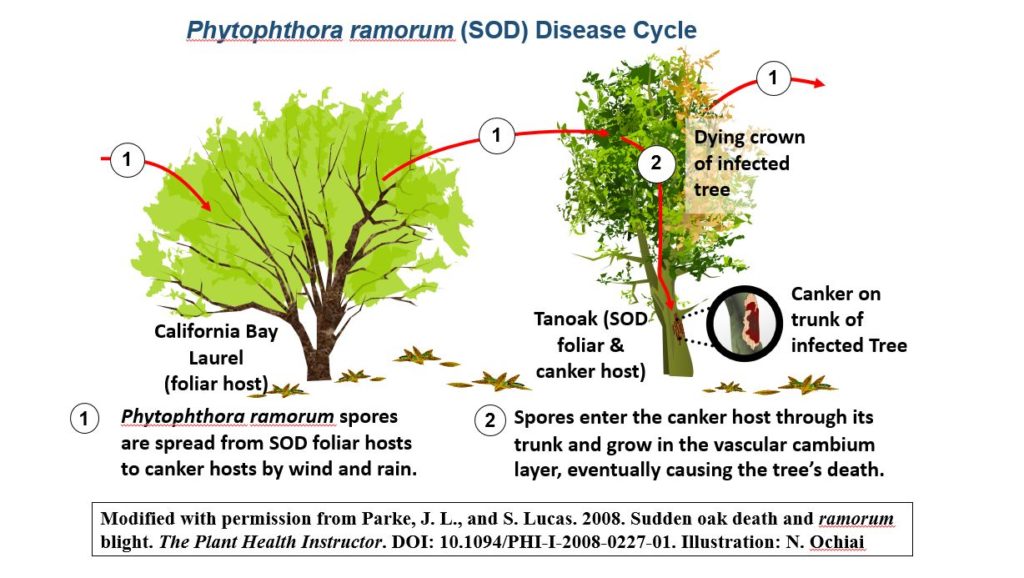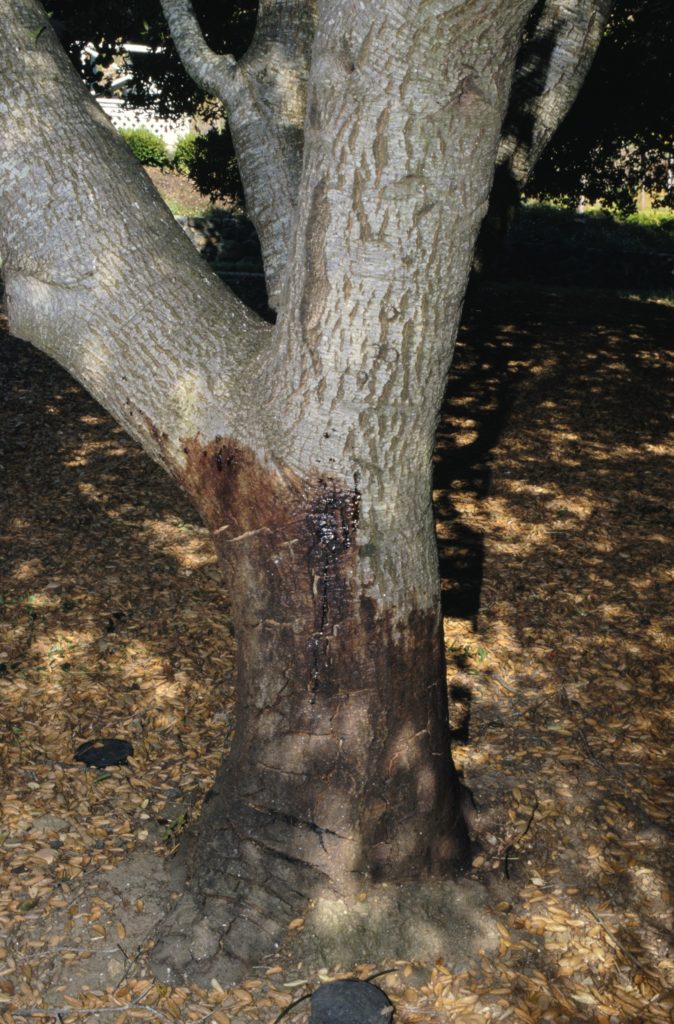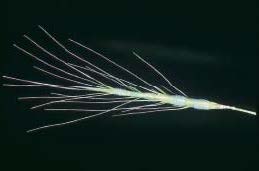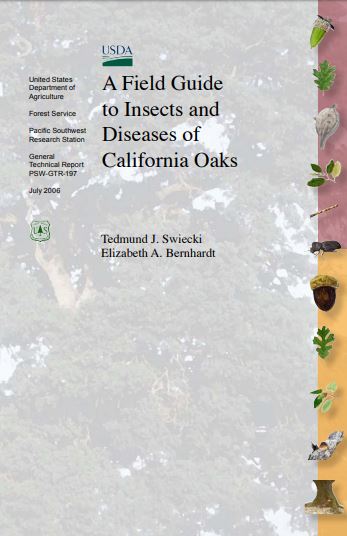Mediterranean Oak Borer (MOB)
The Mediterranean Oak Borer (MOB; Xyleborus monographus) is an introduced ambrosia beetle that was found infesting several valley oak (Quercus lobata) trees in Napa County in 2019. The insect was likely introduced on imported wood products. To date, it has also been detected in Lake, Sonoma, and Sacramento Counties. MOB has been found in several of the oaks in the white oak group, including valley oak, blue oak (Q. douglasii), and Oregon white oak (Q. garryana). The beetle also vectors the fungi, Raffaelea montetyi, which has pathogenic properties.
Collaborative research is ongoing to better understand the ecology and management of MOB, as well as outreach education to help landowner and managers understand the potential impact of this new pest.
Mediterranean Oak Borer Website
UC IPM Pest Alert – Mediterranean Oak Borer
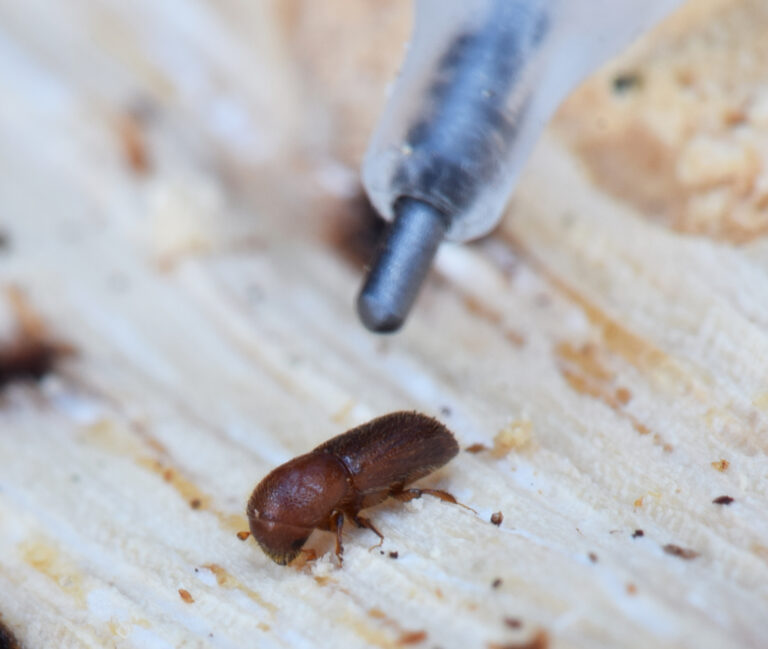
Blue Oak Woodland Mortality
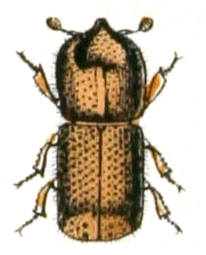
image: Emil Hochdanz / Public domain
Elevated levels of blue oak mortality have been reported in various parts of California over the past few years.
Reported oak mortality tends to occur in a scattered or patchy pattern across the landscape. In some places, other species, such as valley oak have been affected. Concerned landowners have wondered whether another introduced pest or pathogen could be the source of this elevated mortality.
View “Recent Increases in Blue Oak Mortality,” Swiecki,Ted and Elizabeth Bernhardt, Phytosphere Research, April 2020
View “Tree Mortalilty in Blue Oak Woodland During Extreme Drought in Sequoia National Park, California,” Das, Adrian J., Ampersee, Nicholas J., Pfaff, Anne H., Stephenson, Nathan L., Swiecki, Tedmond J., et. al., 2019
Disease: Sudden Oak Death
Sudden Oak Death, or SOD, was first observed in California in 1995. The disease is caused by an introduced pathogen called Phytophthora ramorum.
The California Oak Mortality Task Force (COMTF) is a multi-agency collaborative team focused on understanding this disease and educating the public about how to manage infected stands and curtail the spread of this damaging disease.
Check out the COMTF web site and these links for more information
-
California Oak Mortality Task Force Web Site
-
Protecting Trees from Sudden Oak Death before Infection
-
Sudden Oak Death Pest Notes for Home and Landscape
-
Nursery Guide for Diseases Caused by Phytophthora ramorum on Ornamentals
Invasive Plants: Barbed Goatgrass
Barbed goatgrass (Aegilops triuncialis) is an introduced annual grass that is spreading throughout California grasslands. It is listed as a noxious weed by the California Department of Food and Agriculture and as a wildland weed by the California Exotic Pest Plant Council. When mature, it is unpalatable for livestock. In grasslands, Barbed goatgrass reduces the abundance of native perennial bunchgrasses and competes with more desirable introduced annuals, as well as native forbs.
A Field Guide to Insects and Diseases of California Oaks
Thousands of species of microorganisms and invertebrates inhabit oak woodlands. This book focuses the relatively small number of these are capable of causing damage to oak trees. The more conspicuous of these, for example the California oak worm with may completely defoliate a large tree, draw the most attention because of the nuisance they create, especially in urban areas. However, structurally damaging fungi that decay heart wood often go unnoticed until the tree’s health and trunk and large branches are weakened and, especially in an urban area, may need to be removed. Furthermore, since 1995, sudden oak death disease and the goldspotted oak borer have invaded and killed tens of thousands of coast live oak trees in wildlands of northern and southern California, respectively. This publication provides information that will help tree-care professionals and the general public identify and assess insects and diseases of California Oaks. A much more comprehensive treatment of these agents is provided in California Oak Disease and Arthropod (CODA) database linked on this website (http://Phytosphere.com/coda).
Citation: Swiecki, Tedmund J. and Bernhardt, Elizabeth A. 2006. A field guide to insects and diseases of California oaks. Gen. Tech Rep. PSW-GTR-197. Albany, CA: Pacific Southwest Research Station, Forest Service, U.S. Department of Agriculture, 151 p.
Conifer Encroachment
The loss of deciduous oak woodlands to native conifer encroachment is a major conservation concern in northwestern California and across much of the Pacific Northwest, resulting in associated losses of wildlife habitat, cultural uses, biodiversity, and other ecosystem services. These losses have drawn increasing attention in recent years, and oak woodland conservation and restoration efforts have gained momentum throughout the ranges of Oregon white oak (Quercus garryana) and California black oak (Quercus kelloggii), the two species most afflicted by encroachment … Read more
-
Confier Encroachment
-
UCANR Research
-
Conifer Encroachment Resources
-
Tools for a Changing Landscape research project
Pests: Goldspotted Oak Borer
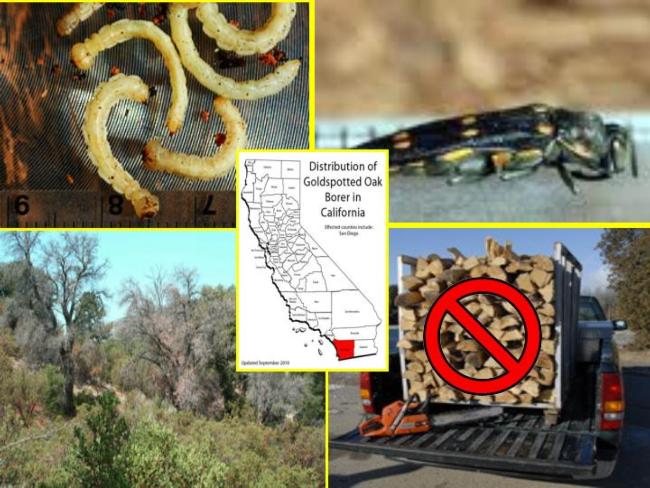
The Gold Spotted Oak Borer (GSOB) is an introduced insect that feeds on coast live oak (Quercus agrifolia) and California black oak (Quercus kelloggii). To date, it can be found in Southern California, in San Diego, Riverside, Orange, Los Angeles and San Bernardino Counties. It is believed that this non-native insect arrived in California during the last two decades, likely from firewood transported to the state from Arizona or Mexico where GSOB is known to live. The University is currently involved in a large educational effort to make the state’s residents understand the threat this insect poses and to advise them on how they can help contain this outbreak. One critical factor in containing the spead of GSOB is to NOT MOVE FIREWOOD from infested areas!
Oaks and Climatic Factors
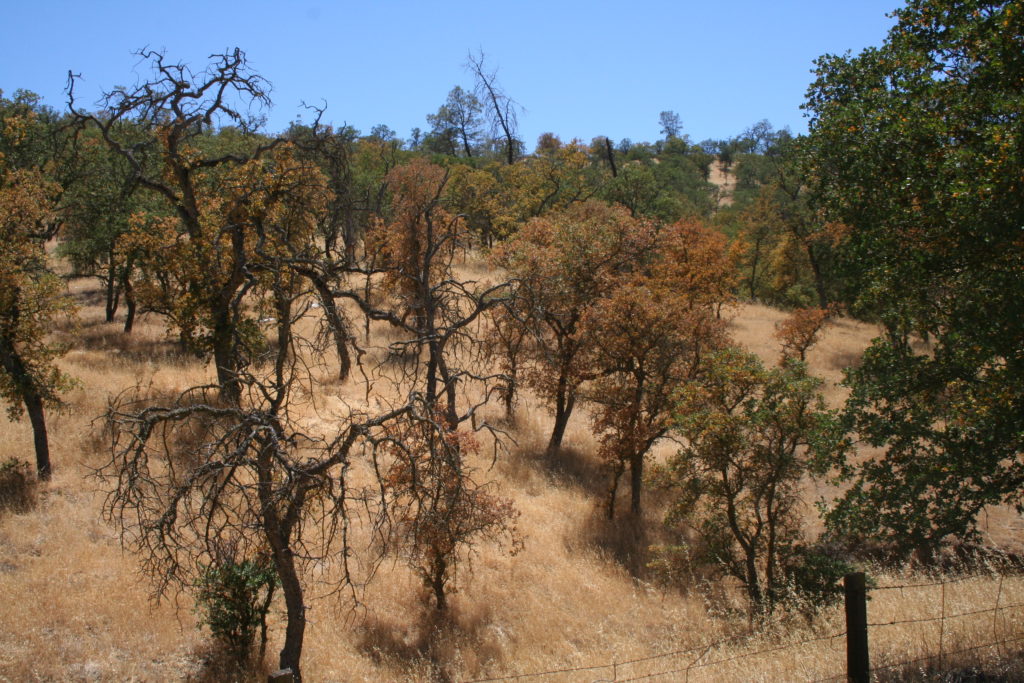
Oaks ‘n Folks Articles – Summaries of journal articles archived from the IHRMP Newsletter
Brown Oak Trees Dot California’s Landscape
The Effects of Drought on California Oaks
Some Native Oaks Succumb to Drought in Coastal Central California
Black Oaks Lose Leaves in El Nino Winter

